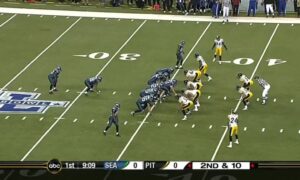By Matthew Marczi
There is no question that, since he was drafted by the Pittsburgh Steelers in the first round of the 207 NFL Draft, inside linebacker Lawrence Timmons has slowly become an integral piece in Dick LeBeau’s defensive arsenal. He has arguably been the team’s best defensive player over the course of the past three seasons.
Much of his success has been predicated upon being unburdened with the setting and play-calling responsibilities that go along with playing the Buck linebacker position, and he has been aided greatly by being paired with experienced and knowledgeable running mates such as James Farrior and Larry Foote.
This year, however, he is left with neither, as Foote sustained a season-ending injury in the opening game. As a result of the loss of one of the team’s key linebackers, LeBeau has resorted to utilizing the rarely seen quarter defensive package, which deploys six defensive backs in a three-safety look. In this sub-package, the Steelers morph into a 5-man front with two down linemen and three linebackers. Timmons plays middle linebacker in these situations, and assumes the Buck responsibilities.
When he is partnered with one of the young linebackers—Vince Williams and Kion Wilson—he is able to play in more familiar territory, as Williams and Wilson have early on displayed an ability to call the defense with little help from Timmons. Timmons is also more comfortable in the Mack role, which generally allows him to play more freely without worrying about beating blockers as much.
The situation led me to ponder whether or not the quarter package is in the best interests of Timmons, and is conducive to getting the most out of him. While the defense as a whole thus far has done reasonably well—not to mention they have spent nearly a quarter of the past two games in the sub-package—is it possible that LeBeau is somewhat neutering one of his best defensive weapons?
I tried to take note during the last game of Timmons’ performance while in the quarter look, and while he was able to make some plays, I did question at times whether or not he was playing as effectively as he could be, whether it is due to taking on more responsibilities or not being used to or as comfortable playing as the sole inside linebacker. The following play is just one example that leads me to wonder if Timmons still has some adjusting to do in order for the defense to be at its best in this sub-package.
On this play, Timmons has two-gap responsibility, and he sells too hard to the one gap—the gap without the fullback leading the way—which leads to a key nine-yard run on second and 10. In the base defense, this would normally be a good read, because he would have the Buck inside linebacker filling the strong gap and taking on the blocker. But he doesn’t have that luxury here.
Troy Polamalu sometimes fills that role in the sub-package, but not on this play. In fact, Timmons directs Polamalu up to the line pre-snap. This play was on Timmons to make, and he got himself caught up in the wash. Sub-packages with defensive backs are obviously an asset, but, as can be seen here, they also have their drawbacks, especially if a player is not as comfortable running it.








